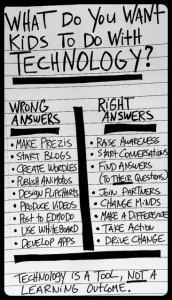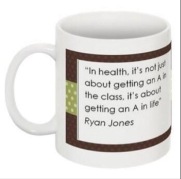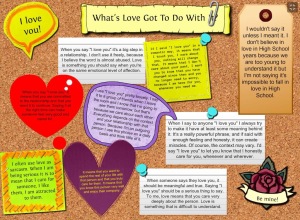When I was at school, the assessment process went something like this:
- Teacher sets assignment
- I attempt the assignment and turn it in
- Teacher grades assignment and returns it
- I throw assignment in the garbage unless it was a good grade (a rarity) and my mom pinned it to the fridge.
Most likely only two sets of eyes saw my work. Mine and the teachers. And that kind of stunk!
 This image is an old one now, I took it from Twitter last year but I have it pinned above my desk at school to remind me that there needs to be a reason for the work that I ask my students to complete. To ask students to work hard on an assignment but then for it to be seen by only them and myself can’t be justified anymore.
This image is an old one now, I took it from Twitter last year but I have it pinned above my desk at school to remind me that there needs to be a reason for the work that I ask my students to complete. To ask students to work hard on an assignment but then for it to be seen by only them and myself can’t be justified anymore.
“If students are sharing their work with the world, they want it to be good. If they’re sharing it with you, they want it to be good enough” – Rushton Hurley
If we want students to raise awareness, start conversations, find answers, join partners, change minds, make a difference, take action and drive change through their work then it is important to find a way for their voice to be heard outside of the four walls of the classroom. For a few years now, Andy Horne and myself have talked about the need to “bridge the gap” between the classroom and the family home and the community. We have a short period of time with our students and so we need to give them the tools that they need to make healthy choices but we also need them to take that information and use it to impact friends and family around them. Only once they have done that can they then look around and advocate for those less health literate than themselves.
You can extend the life of the work created by students by sharing it on social media. Quoting students and then watching their words bounce around the Twittersphere is a pretty cool experience for teachers and students alike.
 Here is an example of student work that was shared on Twitter. I asked students “What advice would you give someone who was being bullied online?”. I liked this response and so used an app called Social Note to turn it into an image that was tweetable. I was able to report back to the student how many ‘impressions’ it had made, how often it was liked and shared and also where in the world her words had traveled. It was a lot further than from the desk to the fridge!
Here is an example of student work that was shared on Twitter. I asked students “What advice would you give someone who was being bullied online?”. I liked this response and so used an app called Social Note to turn it into an image that was tweetable. I was able to report back to the student how many ‘impressions’ it had made, how often it was liked and shared and also where in the world her words had traveled. It was a lot further than from the desk to the fridge!
I used to ask students to write an essay justifying the existence of health on the school curriculum. Whenever students wrote something profound I would print the quote, with their name on it, and display it in the classroom. Eventually there were lots of great quotes on the wall and soon students started quoting other students, even those that they didn’t know, which I thought was pretty powerful. This had the effect of pushing students to think about their writing and come up with something that they hoped would be considered ‘quotable’ by me. Finally, a quote came along that I was so cool I had it  printed onto some coffee mugs. I gave them to the student who supplied the quote, left one in the faculty lounge and the third sits on my desk. Both myself and the student have moved on from that school, but his words still live on.
printed onto some coffee mugs. I gave them to the student who supplied the quote, left one in the faculty lounge and the third sits on my desk. Both myself and the student have moved on from that school, but his words still live on.
By taking the best student work and sharing it with students that follow the next semester or the next year you have the added bonus of saying “this is the minimum quality I expect from you”. Sharing great student work inspires other students to raise their game.
Student work used to be displayed in the classroom when I was a student, and I still see that to a lesser extent nowadays. But today we can record student voices and easily convert it into a podcast, share it online and it can be heard by friends and family across the globe. Here’s an example of a podcast that I made with students at the end of a “Healthy Relationships” unit. This can be used as an assessment tool, be used to flip the classroom for future students, it can be embedded into an iBook, or posted on your school intranet.
One of the activities that we have at school is called “What Is Love” in which we ask students to write what their view of being in love. Here are ways in which I have shared student work, including having student quotes turned into a book using Lulu.
It is my belief that everything that I ask of my students has to be valid. Every word that they write – I promise them that I will read it. I never use a scantron to assess my students as it means that I don’t need to attend to their answers, and that’s not fair on my students. And any time my students produce great work it is only fair of me, with their permission, to share it with other students, teachers, parents (that’s an important one!) and on social media.
Here are this weeks questions. Feel free to keep the conversation flowing on Twitter, don’t feel restricted by the questions.
Q1. When you were a child, did your school work ever get displayed on the fridge? Do you still do that today with your own children? #slowchathealth
Q2. In what ways do you extend the life of student work to share it with others? #slowchathealth
A2 I've used the Toaster GIF app to share 24 examples of student work, words & successes #slowchathealth http://t.co/GJO8X5zIgk—
Andrew Milne (@carmelhealth) July 14, 2015
Q3. How often do you contact parents of students that have impressed you in some way? #slowchathealth
Q4. Would you like to share an example of student work for question 4? #slowchathealth
Q5. In what ways do you bridge the gap between the classroom and the community? #slowchathealth




Reblogged this on Living Active and commented:
I want my students to leave the education system with the ability to become their own nutritionist and personal trainer.
LikeLike